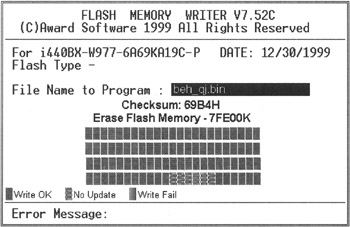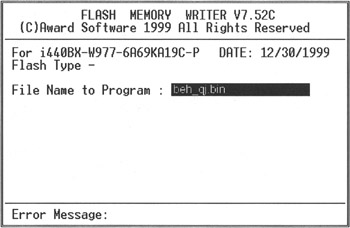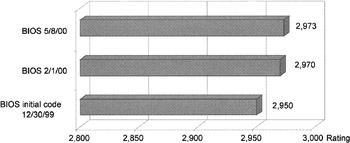BIOS and Computer Performance
|
| < Day Day Up > |
|
Computer performance and functionality don't depend solely on the CPU. On the contrary, they depend on all components of the computer system. The motherboard, whose architecture includes the chipset and the BIOS, plays the central-coordination role. Although the chipset plays the most important role in determining the motherboard parameters, it is not a component that can be replaced. BIOS code, written into the BIOS chip and influencing the operation of most computer subsystems, can be replaced using a special program.
Development and use of new BIOS code can correct existing inconsistencies between BIOS code and motherboard architecture, as well as account for features of new computer components. Besides this, updating BIOS code allows you to benefit from the new features of system and application software, decrease the probability of hardware conflicts, enhance available functionality, and improve overall system performance. For these reasons, it is highly advisable to pay attention to information about the release of new BIOS versions from the moment you purchased a new motherboard.
The functionality enhancements and performance gain that result from updating BIOS code can be illustrated through an example with the following hardware configuration: the Abit BE6-II motherboard and the Intel Pentium 550E processor. Note that the motherboard used in this configuration is considered as one of the most advanced motherboards, providing the broadest range of functional capabilities. Nevertheless, after updating BIOS code, new settings will be available via the BIOS Setup. The test results that follow are evidence of the performance growth achieved with a BIOS update.
Testing the Abit BE6-II Motherboard
The following system configuration was used for testing:
-
Motherboard — Abit BE6-II
-
Processor — Intel Pentium III 550E (Coppermine core, L2 cache of 256 KB, operating at the full core frequency, Slot 1, in box)
-
Hard disk — IBM DPTA-372050 (20 GB, 2 MB cache memory, 7,200 rpm, Ultra DMA/66)
-
RAM — 128 MB, PC100, and M-Tech
-
Video adapter — Asus AGP-V3800 TV (TNT2 video chipset, 32 MB SGRAM)
-
CD-ROM drive — Asus CD-S400/A (40x)
-
Operating system — Windows 98 with Ultra DMA/66 hard-disk controller drivers installed
The following initial BIOS version was used:
-
12/30/99 (beh_po)
The following new BIOS versions were tested:
-
2/1/00 (beh_qj)
-
5/8/00 (beh_rv)
BIOS Update and Testing
The stages of updating BIOS code are outlined in Figs. 5.1 and 5.2.

Figure 5.1: Entering the name of the file containing the updated BIOS code

Figure 5.2: Writing the updated BIOS code into flash ROM
We used WinBench 99 v1.1 tests: CPUmark 99 and FPU WinMark. Test results are in Table 5.1 and in Figs. 5.3 and 5.4.

Figure 5.3: Results of the CPUmark 99 test of a computer with different BIOS versions

Figure 5.4: Results of the FPU WinMark test of a computer with different BIOS versions
| BIOS version | CPUmark 99 | FPU WinMark |
|---|---|---|
| BIOS initial code 12/30/99 | 46.1 | 2,950 |
| BIOS 2/1/00 | 50.7 | 2,970 |
| BIOS 5/8/00 | 51.1 | 2,973 |
As a result of updating BIOS code (beh_po) 12/30/99 with newer versions, the following functional capabilities became available:
-
BIOS (beh_qj) 2/1/00:
-
Elimination of problems with some AGP video adapters at the system-bus frequency of 133 MHz
-
Support for Intel Pentium III processors up to 800 MHz
-
Improved SDRAM compatibility
-
-
BIOS (beh_rv) 5/8/00:
-
Improved parameters at the system-bus frequency of 133 MHz
-
Testing the Abit IT7-MAX2 v2.0 Motherboard
The following system configuration was used for testing:
-
Motherboard — Abit IT7-MAX2 v2.0
-
Processor — Intel Pentium 4 2.4 GHz (Northwood core, L2 cache of 512 KB, operating at full core frequency, FC-PGA slot, in box)
-
Hard disk — IC35L120AVV207-0 (180GXP, 120 GB, 2 MB cache, 7,200 rpm, Ultra DMA/100)
-
RAM — 512 MB, DDR266, Kingston
-
Video adapter — GeForce4 Ti4200, 128 MB
-
CD-ROM — Asus CD-S400/A (40x)
-
Operating system — Windows XP, Service Pack 1
The following initial BIOS version was used:
-
12/16/02 (it7pdf)
The following new BIOS version was used:
-
3/27/03 (it7pd6)
As a result of updating BIOS code, the following improvements and functional capabilities were added:
-
The problem with detection of a low-speed cooler was eliminated. This problem sometimes caused the system to power down automatically without passing the POST routine.
-
The settings for the SP_LED indicator were corrected. After the BIOS code was updated, this indicator corresponded to the following specifications:
-
S0 — Always on
-
S1 — Blinks at high frequency
-
S3 — Blinks at low frequency
-
S4 — Always off
-
S5 — Always off
-
-
The problems with the processor multiplier were eliminated.
-
The processor microcode was updated: 0F24/18, 0F27/33, 0F29/0E.
-
HPT374 BIOS revision 1.23 was used.
The 3DMark2001 SE Pro program was used for testing.
| BIOS version | 3DMark2001 |
|---|---|
| BIOS initial code 12/16/02 | 10,046 |
| BIOS 3/27/03 | 10,120 |

Figure 5.5: Results of the 3DMark2001 SE Pro test of a computer with different BIOS versions
|
| < Day Day Up > |
|
EAN: 2147483647
Pages: 111
- Chapter V Consumer Complaint Behavior in the Online Environment
- Chapter VII Objective and Perceived Complexity and Their Impacts on Internet Communication
- Chapter VIII Personalization Systems and Their Deployment as Web Site Interface Design Decisions
- Chapter X Converting Browsers to Buyers: Key Considerations in Designing Business-to-Consumer Web Sites
- Chapter XII Web Design and E-Commerce